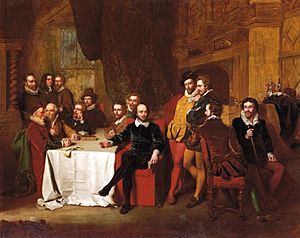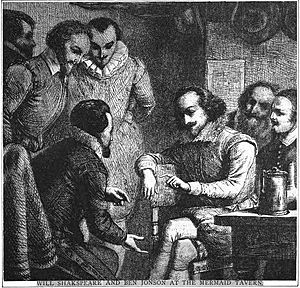Mermaid Tavern facts for kids
The Mermaid Tavern was a famous meeting place in London during the Elizabethan era. It was located near St. Paul's Cathedral on the corner of Friday Street and Bread Street. This tavern was well-known as the home of the "Fraternity of Sireniacal Gentlemen," a special club for writers and thinkers. They met once a month and included some of the most important literary figures of the time.
Some of these famous people were Ben Jonson, John Donne, John Fletcher, Francis Beaumont, and Thomas Coryat. Many people believe that William Shakespeare was also part of this group, though most experts think it's unlikely.
Contents
The Tavern Building
The Mermaid Tavern was on Bread Street, as mentioned by Ben Jonson in his writings. It probably had entrances on both Bread Street and Friday Street. Today, its location would be where Bread Street and Cannon Street meet. The owner of the tavern in 1603 was named William Johnson.
Sadly, the Mermaid Tavern building was destroyed in 1666 during the terrible Great Fire of London.
Shakespeare and the Writers
A writer named William Gifford, who edited Ben Jonson's works in the 1800s, suggested that the club was started by Sir Walter Raleigh in 1603. However, Raleigh was in prison from 1603 to 1616, so it's not likely he was leading tavern meetings.
Gifford was also the first to say that the Mermaid Tavern was where Jonson and Shakespeare had their famous "battle-of-wits" debates. They would discuss many topics, including politics, religion, and literature. People say that Shakespeare, even though he wasn't as formally educated as Jonson, often won these debates. This was because Jonson sometimes got off topic, while Shakespeare stayed focused. We don't know for sure how much of this story is true.
There are many references to the Mermaid Tavern and its clever conversations in old letters and poems. Thomas Coryat's letters, for example, mention the tavern and famous people like Jonson, Donne, and Inigo Jones meeting there.
Shakespeare definitely knew some of the writers who visited the Mermaid Tavern. He also had a connection with the tavern's owner, William Johnson. When Shakespeare bought a gatehouse in Blackfriars in 1613, Johnson was listed as a helper for the mortgage. Also, Hugh Holland, who was mentioned in Coryat's letters, wrote a special poem for the first collection of Shakespeare's plays, called the First Folio, published in 1623.
The group of writers also met at another nearby place called the Mitre tavern. In Ben Jonson's play Bartholomew Fair (1614), one character talks about the "wits" who met at the ‘Three Cranes, Mitre, and Mermaid’. These groups were sometimes seen as a bit too exclusive.
The Mermaid Tavern in Literature
Both Ben Jonson and Francis Beaumont mentioned the Mermaid Tavern in their poems. Jonson's poem Inviting a Friend to Supper talks about "A pure cup of rich Canary wine, / Which is the Mermaid's now, but shall be mine." This shows how special the wine at the Mermaid was.
Beaumont, in a poem to Jonson, described the amazing conversations they had at the Mermaid:
...words that have been
So nimble, and so full of subtle flame,
As if that every one from whence they came,
Had meant to put his whole wit in a jest.
Two hundred years later, in 1819, the poet John Keats wrote a poem called Lines on the Mermaid Tavern. It starts and ends with these lines:
Souls of poets dead and gone,
What Elysium have ye known,
Happy field or mossy cavern,
Choicer than the Mermaid Tavern?
Other writers also found inspiration in the Mermaid Tavern. Theodore Watts-Dunton wrote a Christmas song imagined to be sung there, with each verse "composed" by a different poet guest.
In 1908, A. G. Gardiner used the idea of the Mermaid Tavern's "lively discussions" to describe the brilliant mind of his friend G. K. Chesterton. He said Chesterton was like someone who could join any great company, from ancient myths to famous literary figures, always bringing his unique genius.
From 1892 to 1893, Canadian poets William Wilfred Campbell, Archibald Lampman, and Duncan Campbell Scott wrote a literary column for the Toronto Globe newspaper. They called their column "At the Mermaid Inn".
In 1913, the poet Alfred Noyes published Tales of the Mermaid Tavern. This was a long poem with different chapters, each about an Elizabethan writer connected to the tavern, like Jonson, Shakespeare, and Marlowe.
Finally, in her 1942 book West with the Night, Beryl Markham wrote that "every man has his Mermaid's Tavern," meaning everyone has a special place where they feel welcome and can enjoy good company.
See also
- William Stansby
- Mermaid Series
- Affinity group
Images for kids




